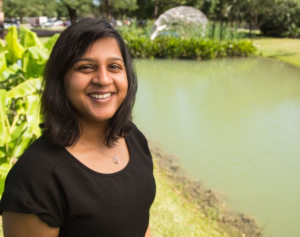Environmental engineering Ph.D. candidate Aparna Balasubramani has found that carbon nanotubes may be the one of the best ways to stop poisonous polychlorinated biphenyls, or PCBs, from entering waterways. Officials at the Texas Water Convention noticed the gravity of her work and awarded her first place at the annual university forum for her paper called “Influence of carbon content in sediment towards sequestration of polychlorinated biphenyls (PCBs) by carbon-based materials.”
In her study, Balasubramani compared emerging nanomaterials with existing carbon-based materials to see which best adsorbs PCBs to reduce contamination. (Absorption is when molecules become assimilated throughout a solid or liquid. Adsorption is when molecules gather on the surface of a solid or liquid.)
“We found that carbon nanotubes performed better than the other four sorbents tested,” said Balasubramani. “If there was a decrease in the organic carbon then higher concentrations of PCBs are seen in the water.” That was proof that carbon nanotubes were adsorbing PCBs which pose human and environmental concerns.
To get that proof, Balasubramani tested historical samples of Galveston bay water and used computer modeling.
Where they come from
Back in the day, before stricter environmental laws, poisonous man-made organic chemicals - PCBs - seemed to flow into the water at full strength, unchanged by anything in their way. Domestically manufactured beginning in 1929, they were banned in 1979, after decades of this electrical byproduct had polluted waterways. Because of their presence in lakes and rivers, PCBs eventually made their way into the food chain, consumed first by fish and eventually by people who ate the fish. And though they’re not manufactured anymore, there is an enormous amount of PCB residue that continues to infect waterways.
Those are some of the issues that Balasubramani is prepared to base her life’s work on remediating. It’s at the heart of her dissertation, and this is not the first time she’s won an award for a study on ridding waters of toxic chemicals. Previously the Battelle organization awarded her at their Ninth International Conference on Remediation and Management of Contaminated Sediments, one of the most prestigious professional gatherings in her field.
Now that she’s won first place on the state level, the Texas Water Convention will send her to the American Water Works Association Annual Conference and Exposition in Philadelphia. There she will represent the state in the Fresh Ideas Poster Session competition.
Then she’ll publish her findings in a journal article so the rest of the world can benefit from her discovery.
Controlling the poison
With her findings, Balasubramani says release of PCBs into waters can be controlled by mixing carbon into sediment. In fact, by doing so she found the amount of PCB could be reduced by 35 percent.
“It gives you an idea of what can be achieved,” she said, excitedly, about the future.
She’s a good one to talk about achievements and the future. With her doctorate in hand, she’ll be testing the waters and making many more of them for years to come.
